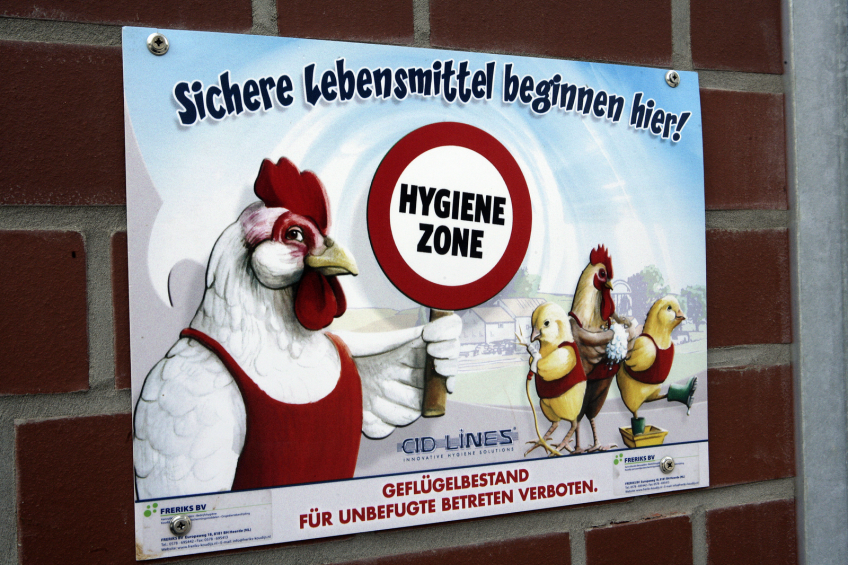Keeping the Avian Influenza virus out

During the most recent Avian Influenza summit, a part of the International Egg Commissions leadership conference in Berlin, the egg industry’s world leaders discussed all the ins and outs of the current Avian Influenza threat. Keeping the virus out, that should be at the forefront of every producer’s mind.
Over the last year, the world had to deal with a serious Avian Influenza crisis. A mutated disease led to infections in many countries and it became a fact of life that the virus has settled in the wild bird population, thus posing a higher threat than before. Some were able to stamp out single incidences of the virus quickly and prevent further spread in the poultry population due to early detection from the farmer up, good organisation and experience. However, in the US the virus was able to get out of control. Chad Gregory of United Egg Producers: “We encountered the worst animal disease outbreak in US history, in which we lost the birds of 223 companies.” Lack of experience and shortcomings in preparation to battle the outbreak exacerbated the problems. Gregory: “In hindsight, we learnt many lessons, ranging from measures to ensure faster depopulation and better organised disposal of dead birds to vaccination and, of course, improved biosecurity and the issue of sharing crews and equipment between farms.”
Also read: AI vaccination, a valuable tool
Verify biosecurity measures
Chairman of United Egg, Jim Dean, lost 5.5 million birds at the farms he is connected to: “We weren’t able to stay ahead of the virus, which meant the virus spread further since we couldn’t cull birds fast enough. With the virus source not under control, we saw other farms become infected.” Dean stated that even before infection of the first farm many biosecurity measures were in place. “That said, we learnt expensive lessons. The first and foremost is – and here I want to quote our past President, Ronald Reagan – ‘Trust, but verify!’ For example, for years we had the rule that our workers couldn’t enter a facility within 72 hours after being in contact with other poultry. When we resigned the agreement, the crew company said they would have to charge us extra to comply with this rule, saying that they thought the rule wasn’t mandatory before.”
Disasters happen
“And that is exactly where disasters happen,” added professor Rudi Preisinger of Lohmann Tierzucht. “Let’s be honest with each other. Do you have a full shower-in, shower-out procedure in place, do you have colour-coded boots and clothes for every zone on your farm? We all know that is not the case in most operations. All producers within the IEC should lead by example. In my world, someone should change shoes from black to green when he steps from the outside the farm onto the farm grounds and change again from green to yellow when he steps inside the house. And when I see someone go outside for a quick cigarette with his yellow boots on? Then simply changing shoes won’t cut it, he’ll have to change companies.”
Also read: US: APHIS boosts workers in wake of avian influenza
The ideal farm
Biosecurity is more than just a shower and shoe operation, it is all about protocols and being prepared for the worst. Andrew Joret of the British Egg Producing Council: “Biosecurity not only keeps out Avian Influenza, all kinds of pathogens, viruses and bacteria can be kept at bay with strict hygiene.” Unfortunately most farms have to deal with an existing situation. “That doesn’t mean, however, that the existing protocols cannot be changed. As a thought exercise, I often challenge farmers to imagine the perfect model farm with perfect human and animal movements.”
According to Joret, one can learn a lot this way, which can lead to changes in an existing situation. “A model farm wouldn’t be built near open water or other poultry concentrations, it would have a perimeter fence with only one entry point with a barrier, parking outside and disinfecting facilities. The farm would have a single age system and the building would be tight and chickens would be indoors.” In Joret’s opinion, there is a lot to learn from this thought exercise that can be implemented on existing farms without enormous investments or big changes. “Restricting the number of visitors will cost you nothing and having your employees park outside the farm to prevent ‘dirty’ vehicles from entering the farm grounds will be cheap. Disinfecting the few vehicles that are allowed on farms will not be expensive. And why should you allow the feed truck to enter, supplying the house from outside the fence is a possibility too. And what about service personnel? Do you allow them to bring their own tools and toolbox, which could have been at another farm as well? Or do you invest in farm-owned tools?”
Also read: Case study: Mexico rebounds after AI
Flanking measures
Only when the farms’ biosecurity is up to speed, backed up with rapid diagnosis to detect possible outbreaks and a well-organised culling and disposal system is there room for taking measures such as vaccination. Professor Hafez of the University of Berlin: “Vaccination can be used as a flanking measure in cases of extreme threat or an uncontrollable outbreak. But it is no substitute for preparation. When a vaccination strategy is in place, it can give producers a false sense of security, leading to less tight biosecurity protocols. That is deadly because no single vaccination will give 100% protection in field conditions or stop a virus spreading.” With the virus present in the direct environment of the world’s poultry population, preventing the virus from entering the house requires maximum attention, using trusted and verified best practices.













